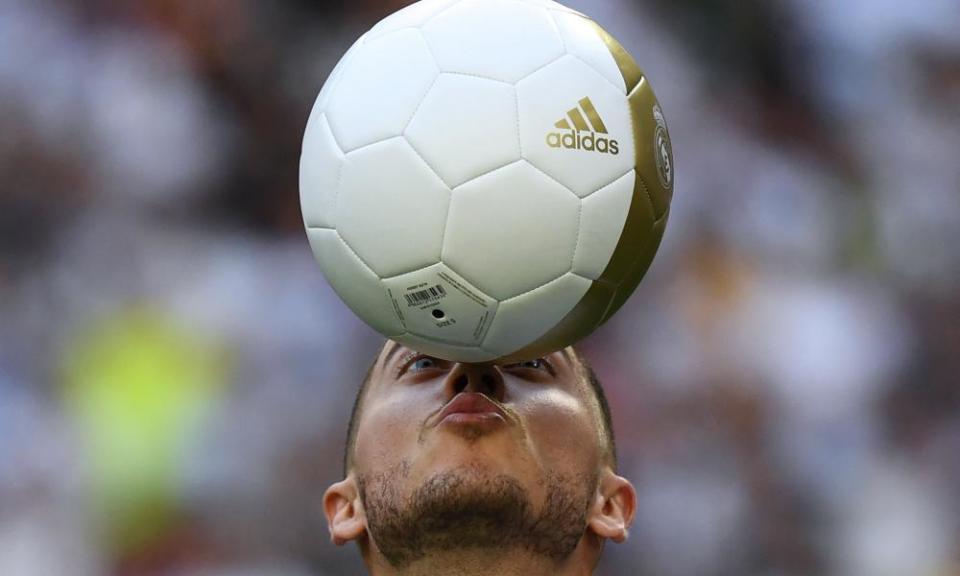Which football clubs have spent the most money in a transfer window?

“Chelsea spent around £300m in January. Is this a record for a single transfer window?” asks James McWilliam Woods.
It is indeed, breaking the record set by Real Madrid in the summer of 2019. The figures for each club’s expenditure tend to vary from source to source because of exchange rates, potential add-ons and the like, but according to our interactive guide to that particular window, Madrid spent £278.3m. More than half of that went on Eden Hazard (£88.5m) and Luka Jovic (£57.7m), who both flopped badly, but they did at least get value for money from Éder Militão (£44m), Ferland Mendy (£44m) and Rodrygo (£40m).

Chelsea’s summer 2022 splurge is in third place, with Wesley Fofana, Marc Cucurella, Raheem Sterling, Kalidou Koulibaly and the rest costing around £260m. There’s no consensus over which team sits fourth on the list because of the aforementioned variance, but there are a number of teams who everyone agrees have spent more than £200m in a single window. In chronological order, they are:
Real Madrid (summer 2009): Cristiano Ronaldo, Kaká, Karim Benzema, Xabi Alonso et al.
Manchester City (summer 2017): Benjamin Mendy, Kyle Walker, Bernardo Silva, Ederson, Danilo et al.
Paris Saint-Germain (summer 2017): Neymar et al.
Juventus (summer 2018): Cristiano Ronaldo, João Cancelo, Douglas Costa, Leonardo Bonucci et al.
Barcelona (summer 2019): Antoine Griezmann, Frenkie de Jong, Neto, Junior Firpo et al.
Chelsea (summer 2020): Kai Havertz, Ben Chilwell, Timo Werner, Hakim Ziyech, Édouard Mendy, Thiago Silva et al.
Manchester United (summer 2022): Antony, Casemiro, Lisandro Martínez, Tyrell Malacia, Christian Eriksen et al.
You’ll note that all of these were during summer transfer windows. We can’t be sure of the previous January record – we suspect it’s Barcelona in 2018, when they spent almost £150m on Philippe Coutinho and Yerry Mina – but we do know Chelsea have obliterated it.
Futile fortresses
“Has a team ever been relegated despite going unbeaten all season at home? Asking for a friend,” tweets @SwindonImp.
Anyone with a GCSE in club nicknames will know this question refers to Lincoln City, also known as the Imps. They are currently 16th in League One, seven points above the relegation places. That’s despite – or perhaps because of – an unusual home record: P13 W2 D11 L0.
Let’s start with the trick answer. Juventus were unbeaten at home in 2005-06, winning 14 and drawing five en route to the Serie A title. Two months later they were stripped of the title and relegated because of their part in the Calciopoli scandal.
There are loads of teams who have gone down despite suffering only a couple of home defeats. One of the more famous is Chelsea, when they were last relegated in 1987-88. Their home record was P20 W7 D11 L2 (it was a 21-team league) but a wretched away record (W2 D4 L14) meant they finished fourth bottom and went into a relegation playoff with Middlesbrough, who finished third in Division Two. It summed up Chelsea’s season: they lost the first leg 2-0 at Ayresome Park and won the second 1-0 at Stamford Bridge. The home fans responded to the team’s relegation with violence and a pitch invasion, but that’s another story.

In the 1974-75 La Liga season, both Celta Vigo and Málaga went down despite losing only two of their 17 home games. Celta were even more unfortunate two years later. Having bounced back at the first attempt, they were relegated again despite losing only one home game, a 1-0 defeat to Salamanca. In fact, they didn’t even concede a goal at home to any of the teams that finished in the top 10. Their overall home record was W9 D7 L1. They were relegated because of a desperate away record: W0 D4 L13.
Before the twin stimulants of the change in the backpass law and the introduction of three points for a win, Italy was the spiritual home of the draw. That and a culture of enormous home advantage meant a number of teams went down with very few home defeats. Serie B is even more fertile ground than Serie A for this question. Cavese (1983-84), Campobasso (1986-87), Empoli (1988-89) and Salernitana (1990-91) were all relegated despite suffering only one home defeat in a 38-game season.
The following year Palermo went one better, if that’s the right word, by turning Stadio La Favorita into a futile fortress. Their home record (W11 D8 L0) was outstanding – no team in the league picked up more points – but their away record was a warped mirror image (W0 D5 L14) and they were relegated to Serie C1. (In fact, Palermo didn’t lose a home game in the league between December 1989 and February 1993, a 53-game run that included one promotion, one relegation and another imminent promotion.)
The Serie B table for that 1991-92 season demonstrates how strong home advantage was in Italy, especially in the lower leagues. No team lost more than five games at home or won more than five away (Ancona’s away record is a misprint – it should be, and you’ll like this, W1 D15 L3).
Quickfire fixture doubles
@TheKnowledge_GU One for next Wednesday:
Manchester United host Leeds tonight, before going to Elland Road on Sunday for the return fixture.
When was the last time that two teams completed their league match-ups so quickly? Maybe when they used to do Christmas double-headers?— Jim Hearson (@JimHearson) February 2, 2023
There were indeed Christmas double-headers until the mid-1960s, with teams often playing each other on Boxing Day and then again on 27 December. But the most recent example of two teams meeting on consecutive days that we can find, certainly in the English top flight, occurred during the 1985-86 season.
Postponements and cup replays meant Arsenal and Watford ended up meeting at Highbury on 31 March 1986 and Vicarage Road on 1 April 1986. Funnily enough, the second of those games had originally been scheduled for Boxing Day.
Arsenal were in disarray at the time, and Watford won both games by a combined score of 5-0. You can read more about it in Steven Pye’s archive piece.

There have been a few back-to-back fixtures since then, including Bolton v Arsenal on 17 and 20 January 2010, but none on consecutive days that we can find.
Double hat-tricks (2)
In last week’s Knowledge, we looked at double hat-tricks scored by players in Europe’s top five leagues. We thought the most recent was when Dieter Müller hit six hit six in FC Köln’s 7-2 win over Werder Bremen at the start of the 1977-78 season. Not for the last time, we were wrong.
The ever-reliable Dirk Maas has written it to tell us about the one that got away. Or rather the six. In Ligue 1, on 28 April 1984, Metz won 7-3 at soon-to-be-relegated Nîmes, and all bar one of the goals were scored by their Yugoslavia-born striker Tony Kurbos.
It was a seriously good year for Kurbos. He made one and scored one when Metz beat Monaco in the Coupe de France final a couple of weeks later. That put them into the Cup Winners’ Cup, and in October Kurbos scored a hat-trick when they humiliated a hubristic Barcelona at Camp Nou.
Knowledge archive
“What is the shortest time between a referee awarding two penalties?” asked James Crane in 2011.
First up was Claudio Kristeller: “In a match between Palmeiras and Avaí in the 2010 Brazilian Championship, Palmeiras took a penalty, the keeper saved it, but the ref saw a foul in the fight for the rebound and awarded another penalty. It took about seven seconds from first kick to the whistle.”
And the Avaí goalkeeper Zé Carlos was sent off after picking fights before and after the penalty. It’s well worth watching (from about 5m 20s):
But in 2011, Athletic Bilbao and Málaga were even quicker off the mark. “Athletic’s David López smacked a penalty against the bar,” wrote Claudio Gameiro, “with the ball rebounding on to the arm of defender Eliseu. He was penalised for handball and López scored the second penalty. There were around four seconds between the first kick being taken and the second being awarded, but only one second between López’s kick and the ball hitting Eliseu’s arm. You can watch it here, with the fun and games beginning after about 4m 50s.”
Can you help?
“Last weekend, Ángel Correa scored, had a goal taken away for offside, was substituted and only then awarded the goal after video review. Has anyone ever scored after having officially left the field before? Aside from goals committees, I’m curious if it ever happened before VAR,” muses Ben Cordes.
@TheKnowledge_GU Having just discovered that Slade's 1978 single, give us a goal (it flopped), had a video filmed at Brighton's Goldstone ground. What other music videos have been filmed at football stadiums?
— phil withall (@phil_withall) February 2, 2023
“After reading that André Ayew is the 30th player to join Nottingham Forest this season, I wondered which club has had the most new footballers signed during one season?” wonders Bogdan Kotarlic.
We all know about managers buying their favourite players over and over again at different clubs - but which managers have _sold_ the same player multiple times because they keep taking over the club where said player has ended up?
— Doremus Schafer (@DoremusSchafer) February 7, 2023
“Manchester United recently rejected a bit of £500,000 – 25% more than the world record – for Alessia Russo. How many other clubs (men’s or women’s) have rejected a world-beating fee for a player?” asks James McWilliam Woods.
Ivan Perisic has 9 assists and 0 goals for Spurs. What's the (season, club or career) record for being always the bridesmaid and never the bride?
— Doremus Schafer (@DoremusSchafer) February 7, 2023
Mail us your questions or tweet @TheKnowledge_GU.

 Yahoo Movies
Yahoo Movies 
